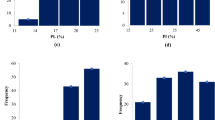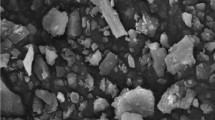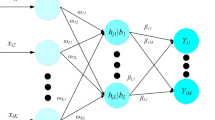Abstract
The prediction of the uniaxial compression strength (qu) of soil cement mixtures is of up most importance for design purposes. This is done traditionally by extensive laboratory tests which is time and resources consuming. In this paper, it is presented a new approach to assess qu over time based on the high learning capabilities of data mining techniques. A database of 444 records, encompassing cohesionless to cohesive and organic soils, different binder types, mixture conditions and curing time, were used to train three models based on support vector machines (SVMs), artificial neural networks (ANNs) and multiple regression. The results show a promising performance in qu prediction of laboratory soil cement mixtures, being the best results achieved with the SVM model (\(R^2 = 0.94\)) and with an average of SVM and ANN model (\(R^2 = 0.95\)), well reproducing the major effects of the input variables water/cement ratio, cement content, organic matter content and curing time, which are known as preponderant in soil cement mixtures behaviour.
Similar content being viewed by others
References
Bi J, Bennett K (2003) Regression error characteristic curves. In: Proceedings of the twentieth international conference on machine learning. AAAI Press, Washington, DC, USA, pp 43–50
Chen H, Wang Q (2006) The behaviour of organic matter in the process of soft soil stabilization using cement. Bull Eng Geol Environ 65(4):445–448
Cherkassky V, Ma Y (2004) Practical selection of SVM parameters and noise estimation for SVM regression. Neural Netw 17(1):113–126
Consoli NC, Rosa DA, Cruz RC, Dalla Rosa A (2011) Water content, porosity and cement content as parameters controlling strength of artificially cemented silty soil. Eng Geol 122(3–4):328–333
Correia A (2011) Applicability of deep mixing technique to the soft soil of Baixo Mondego. Ph.D. thesis, School of Engineering, University of Coimbra, Coimbra, Portugal
Correia AG, Tinoco J, Cortez P (2014) Use of data mining in design of soil improvement by jet grouting. In: Toll DG (ed) Second international conference on information technology in geo-engineering (ICITG 2014). IOS Press, Durham, pp 43–63
Correia AA, Oliveira PJV, Custódio DG (2015) Effect of polypropylene fibres on the compressive and tensile strength of a soft soil, artificially stabilised with binders. Geotext Geomembr 43(2):97–106
Cortes C, Vapnik V (1995) Support vector networks. Mach Learn 20(3):273–297
Cortez P (2010) Data mining with neural networks and support vector machines using the R/rminer tool. In: Perner P (ed) Advances in data mining: applications and theoretical aspects, 10th industrial conference on data mining. LNAI 6171. Springer, Berlin, pp 572–583
Cortez P, Embrechts M (2013) Using sensitivity analysis and visualization techniques to open black box data mining models. Inf Sci 225:1–17
Deepa N, Ganesan K (2016) Multi-class classification using hybrid soft decision model for agriculture crop selection. Neural Comput Appl 30(4):1025–1038
Domingos P (2012) A few useful things to know about machine learning. Commun ACM 55(10):78–87
Emamgholizadeh S, Bahman K, Bateni SM, Ghorbani H, Marofpoor I, Nielson JR (2017) Estimation of soil dispersivity using soft computing approaches. Neural Comput Appl 28(1):207–216
Gilan S, Bahrami Jovein H, Ramezanianpour A (2012) Hybrid support vector regression–particle swarm optimization for prediction of compressive strength and RCPT of concretes containing metakaolin. Constr Build Mater 34:321–329
Hastie T, Tibshirani R, Friedman J (2009) The elements of statistical learning: data mining, inference, and prediction, 2nd edn. Springer, New York
Horpibulsk S, Rachan R, Suddeepong A, Chinkulkijniwat A (2011) Strength development in cement admixed bangkok clay: laboratory and field investigations. Soils Found 51(2):239–251
Horpibulsuk S, Rachan R, Suddeepong A (2011) Assessment of strength development in blended cement admixed Bangkok clay. Constr Build Mater 25(4):1521–1531
Inbarani HH, Kumar SU, Azar AT, Hassanien AE (2018) Hybrid rough-bijective soft set classification system. Neural Comput Appl 29(8):67–78
Kenig S, Ben-David A, Omer M, Sadeh A (2001) Control of properties in injection molding by neural networks. Eng Appl Artif Intell 14(6):819–823
Lee FH, Lee Y, Chew SH, Yong KY (2005) Strength and modulus of marine clay–cement mixes. J Geotech Geoenviron Eng 131(2):178–186
Liao S, Chu P, Hsiao P (2012) Data mining techniques and applications. A decade review from 2000 to 2011. Expert Syst Appl 39(12):11303–11311
Lorenzo G, Bergado D (2004) Fundamental parameters of cement-admixed clay—new approach. J Geotech Geoenviron Eng 130(10):1042–1050
McCulloch WS, Pitts W (1943) A logical calculus of the ideas immanent in nervous activity. Bull Math Biophys 5(4):115–133
R Development Core Team (2009) R: a language and environment for statistical computing. R Foundation for Statistical Computing, Vienna
Sariosseiri F, Muhunthan B (2009) Effect of cement treatment on geotechnical properties of some Washington state soils. Eng Geol 104(1–2):119–125
Smola A, Schölkopf B (2004) A tutorial on support vector regression. Stat Comput 14(3):199–222
Tinoco J, Gomes Correia A, Cortez P (2011) Application of data mining techniques in the estimation of the uniaxial compressive strength of jet grouting columns over time. Constr Build Mater 25(3):1257–1262
Tinoco J, Correia AG, Cortez P (2014) A novel approach to predicting Young’s modulus of jet grouting laboratory formulations over time using data mining techniques. Eng Geol 169:50–60. https://doi.org/10.1016/j.enggeo.2013.11.015
Tinoco J, Alberto A, da Venda P, Correia AG, Lemos L (2016) A data-driven approach for qu prediction of laboratory soil-cement mixtures. Procedia Eng 143:566–573. https://doi.org/10.1016/j.proeng.2016.06.073
Venda Oliveira PJ, Correia AA, Garcia MR (2012) Effect of organic matter content and curing conditions on the creep behavior of an artificially stabilized soil. J Mater Civ Eng 24(7):868–875
Venda Oliveira PJ, Correia AA, Garcia MR (2013) Effect of stress level and binder composition on secondary compression of an artificially stabilized soil. J Geotech Geoenviron Eng 139(5):810–820
Venda Oliveira PJ, Correia AA, Lopes TJ (2014) Effect of organic matter content and binder quantity on the uniaxial creep behavior of an artificially stabilized soil. J Geotech Geoenviron Eng 140(9):04014053
Werbos P (1974) Regression: new tools for prediction and analysis in the behavioral sciences. Ph.D. thesis, Harvard University, Harvard, USA
Acknowledgements
This work was supported by FCT - “Fundação para a Ciência e a Tecnologia”, within ISISE, project UID/ECI/04029/2013, and within CIEPQPF, project EQB/UI0102/2014, as well Project Scope: UID/CEC/00319/2013 and through the post-doctoral Grant fellowship with reference SFRH/BPD/94792/2013. This work was also partly financed by FEDER funds through the Competitivity Factors Operational Programme - COMPETE and by national funds through FCT within the scope of the projects POCI-01-0145-FEDER-007633, POCI-01-0145-FEDER-007043 and POCI-01-0145-FEDER-028382.
Author information
Authors and Affiliations
Corresponding author
Additional information
Publisher's Note
Springer Nature remains neutral with regard to jurisdictional claims in published maps and institutional affiliations.
Rights and permissions
About this article
Cite this article
Tinoco, J., Alberto, A., da Venda, P. et al. A novel approach based on soft computing techniques for unconfined compression strength prediction of soil cement mixtures. Neural Comput & Applic 32, 8985–8991 (2020). https://doi.org/10.1007/s00521-019-04399-z
Received:
Accepted:
Published:
Issue Date:
DOI: https://doi.org/10.1007/s00521-019-04399-z










